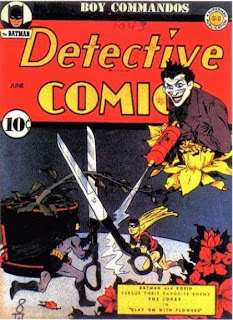"Slay 'Em With Flowers"
Writer: Horace L. Gold
Artist: Jerry Robinson
Synopsis: The Joker and his men have taken over an old florists' shop, using it as a front for buglarizing wealthy patrons. The flowers are delivered, release a gas which knocks out the guards and inhabitants of the building, and then Joker and his men bust in wearing gas masks and steal the loot.
The cops can't figure how it's being done, so the Bat-Signal calls the Dynamic Duo to police headquarters, and the next day Bruce Wayne is taking Dick to a "flower show" based on a hunch from the case.
Of course the Joker and his men are robbing the place and so Batman and Robin appear for the fight -- but the gas gets them, and once unconscious the Joker's men place them in an elevator car and cut the cables (rather than just, y'know, shooting them).
The masked manhunters manage to wake up and hit the emergency stop lever in time, and escape. Batman recognizes there must be a connection between the gas and the flowers and does some detective work. Batman and Robin stake out the Florist shop, and then follow millionaire Percy Fillmore from the shop to his penthouse apartment.
They arrive in time to find the Joker's men robbing the place, but Joker shoots them in the face with gas. The crooks stick our heroes in a closet and run gas from the kitchen into the room to suffocate them. Once again they wake up in time, and bust out. Robin suggests raiding the flower shop, but Batman feels the Joker is keeping the loot at a second location.
So Bruce Wayne goes to the flower shop to set himself up as bait. Upon delivery of the flowers to Wayne Manor Bruce notes that the soil is rigged to release a spray of chloroform on a timer.
Alfred suggests fighting the Joker's men when they arrive, but Bruce explains that they must pretend they've been drugged otherwise the Joker and his men would surely kill them. Alfred, an upper crust British guy in 1943, doesn't understand a policy of non-resistance. Oh-ho, contemporary events joke!
After the Joker's gang robs Wayne Manor, the Batmobile follows them to a greenhouse on the outskirts of town, where our climatic fight scene begins. Joker holds up in the greenhouse, but Batman instructs Robin to wet their capes and wear them as gas masks while the Dark Knight pumps chloroform into the greenhouse air intake!
And so with the villains heavily drugged, the police are called and everyone sent to jail.
~~~~
My Thoughts: This is a basic Batman tale. Boilerplate stuff. Joker has a scheme involving robbing folks. He does it once successfully, once again fighting Batman, then the third time is the bait and switch ending with a chase and a climatic fight. This is formula. But "Slay 'Em With Flowers" is still a good read for a few reasons, even if as a Joker story it is uninspired.
The Art: The absolute best thing about this story is the art. Jerry Robinson hits it out of the park here, drawing in a dark, rough style that really feels noirish and pulpy. People's suits and baggy and get wrinkled. Joker is thin and wiry and his hair get messed up. Batman has a chin so big and square that it makes the art of George Freeman looked restrained. It's really lovely to look at and it's a big element making the story feel better than it is. For a long time Robinson was an unsung hero of Golden Age Batman (just like most everyone else), and it was great that before his death he finally got some recognition, even if it was usually accompanied by an exaggerated "creator of the Joker" title. Still more than anything Bill Finger got when he was alive.
The Story: That the story is so formulaic is mildly disappointing considering who is writing it -- H.L. Gold, the classic Golden Age science fiction author who transformed the genre with his magazine Galaxy Science Fiction in 1949. However those days of innovation are a few years away and in 1943 Gold was simply another stuggling sci-fi author making ends meet by slumming it in comics. That being said, Gold slums it quite well, following the formula, constructing the tale in a coherent manner, and wrapping it up nicely. It does the job and does it expertly, even if there's no real innovation on display here.
